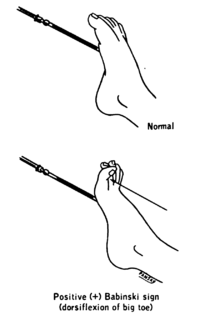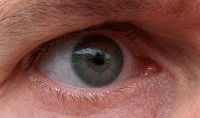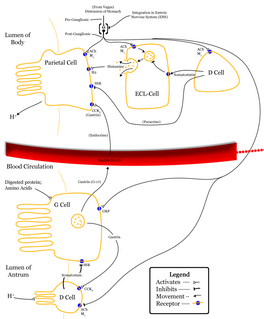Related Research Articles
The Aplysia gill and siphon withdrawal reflex (GSWR) is an involuntary, defensive reflex of the sea hare Aplysia californica, a large shell-less sea snail or sea slug. This reflex causes the sea hare's delicate siphon and gill to be retracted when the animal is disturbed. Aplysia californica is used in neuroscience research for studies of the cellular basis of behavior including: habituation, dishabituation, and sensitization, because of the simplicity and relatively large size of the underlying neural circuitry.

The plantar reflex is a reflex elicited when the sole of the foot is stimulated with a blunt instrument. The reflex can take one of two forms. In healthy adults, the plantar reflex causes a downward response of the hallux (flexion). An upward response (extension) of the hallux is known as the Babinski response or Babinski sign, named after the neurologist Joseph Babinski. The presence of the Babinski sign can identify disease of the spinal cord and brain in adults, and also exists as a primitive reflex in infants.
A mechanoreceptor, also called mechanoceptor, is a sensory cell that responds to mechanical pressure or distortion. There are four main types of mechanoreceptors in glabrous, or hairless, mammalian skin: lamellar corpuscles, tactile corpuscles, Merkel nerve endings, and bulbous corpuscles. There are also mechanoreceptors in hairy skin, and the hair cells in the receptors of primates like rhesus monkeys and other mammals are similar to those of humans and also studied even in early 20th century anatomically and neurophysiologically.

The cremasteric reflex is a superficial reflex observed in human males.
According to Alonso and Chen (2008),
The receptive field is a portion of sensory space that can elicit neuronal responses when stimulated. The sensory space can be defined in a single dimension, two dimensions or multiple dimensions. The neuronal response can be defined as firing rate or include also subthreshold activity.

The acoustic reflex is an involuntary muscle contraction that occurs in the middle ear in response to loud sound stimuli or when the person starts to vocalize.

Referred pain, also called reflective pain, is pain perceived at a location other than the site of the painful stimulus. An example is the case of angina pectoris brought on by a myocardial infarction, where pain is often felt in the neck, shoulders, and back rather than in the thorax (chest), the site of the injury. The International Association for the Study of Pain has not officially defined the term; hence several authors have defined it differently.

The corneal reflex, also known as the blink reflex, is an involuntary blinking of the eyelids elicited by stimulation of the cornea, though could result from any peripheral stimulus. Stimulation should elicit both a direct and consensual response. The reflex occurs at a rapid rate of 0.1 seconds. The purpose of this reflex is to protect the eyes from foreign bodies and bright lights. The blink reflex also occurs when sounds greater than 40–60 dB are made.

The scratch reflex is a response to activation of sensory neurons whose peripheral terminals are located on the surface of the body. Some sensory neurons can be activated by stimulation with an external object such as a parasite on the body surface. Alternatively, some sensory neurons can respond to a chemical stimulus that produces an itch sensation. During a scratch reflex, a nearby limb reaches toward and rubs against the site on the body surface that has been stimulated. The scratch reflex has been extensively studied to understand the functioning of neural networks in vertebrates. Despite decades of research, key aspects of the scratch reflex are still unknown, such as the neural mechanisms by which the reflex is terminated.
In medicine, Intermittent Photic Stimulation, or IPS, is a form of visual stimulation used in conjunction with electroencephalography to investigate anomalous brain activity triggered by specific visual stimuli, such as flashing lights or patterns.

Vagovagal reflex refers to gastrointestinal tract reflex circuits where afferent and efferent fibers of the vagus nerve coordinate responses to gut stimuli via the dorsal vagal complex in the brain. The vagovagal reflex controls contraction of the gastrointestinal muscle layers in response to distension of the tract by food. This reflex also allows for the accommodation of large amounts of food in the gastrointestinal tracts.
Galant reflex, or truncal incurvation reflex, is a newborn reflex, named after neurologist Johann Susmann Galant. It is elicited by holding the newborn in ventral suspension and stroking along the one side of the spine. The normal reaction is for the newborn to laterally flex toward the stimulated side.

A hypercomplex cell is a type of visual processing neuron in the mammalian cerebral cortex. Initially discovered by David Hubel and Torsten Wiesel in 1965, hypercomplex cells are defined by the property of end-stopping, which is a decrease in firing strength with increasingly larger stimuli. The sensitivity to stimulus length is accompanied by selectivity for the specific orientation, motion, and direction of stimuli. For example, a hypercomplex cell may only respond to a line at 45˚ that travels upward. Elongating the line would result in a proportionately weaker response. Ultimately, hypercomplex cells can provide a means for the brain to visually perceive corners and curves in the environment by identifying the ends of a given stimulus.
The palmomental reflex (PMR) is a primitive reflex consisting of a twitch of the chin muscle elicited by stroking a specific part of the palm. It is present in infancy and disappears as the brain matures during childhood but may reappear due to processes that disrupt the normal cortical inhibitory pathways. Therefore, it is an example of a frontal release sign.

The neural basis of prey detection, recognition, and orientation was studied in depth by Jörg-Peter Ewert in a series of experiments that made the toad visual system a model system in neuroethology. He began by observing the natural prey catching behavior of the common European toad.
The bulbocavernosus reflex (BCR), bulbospongiosus reflex (BSR) or "Osinski reflex" is a polysynaptic reflex that is useful in testing for spinal shock and gaining information about the state of spinal cord injuries (SCI). Bulbocavernosus is an older term for bulbospongiosus, thus this reflex may also be referred to as the bulbospongiosus reflex.
In psychology, a stimulus is any object or event that elicits a sensory or behavioral response in an organism.
Boris Khodorov was a Soviet and Russian physiologist, M.D., D.Sc., Professor of Physiology, and Head of the Cell Physiology section of Moscow Physiological Society.
Anatoly Zubkov was a Soviet physiologist, D.Sc.. He held the chair of physiology in the Kishinev Medical Institute. Prof. Anatoly Zubkov had published over sixty works on the various problems of the physiology and pathology of the heart and the nervous and endocrine control of functions. He was the first to translate classic works by Ivan Sechenov into English.
References
- ↑ Babsky, Evgeni; Boris Khodorov; Grigory Kositsky; Anatoly Zubkov (1989). Babsky, Evgeni (ed.). Human Physiology, in 2 vols. 2. Translated by Ludmila Aksenova. Translation edited by H. C. Creighton (M.A., Oxon). Moscow: Mir Publishers. ISBN 5-03-000776-8 First published in Russian as «Физиология человека»
- ↑ Kiselev P. A. Reflexogenous Zone // The Great Soviet Encyclopedia, 3rd Edition.